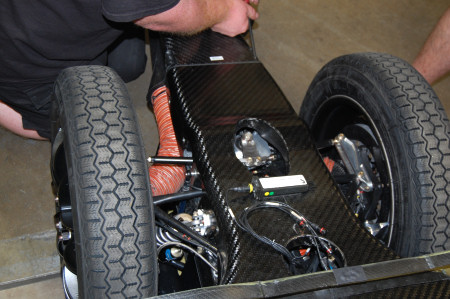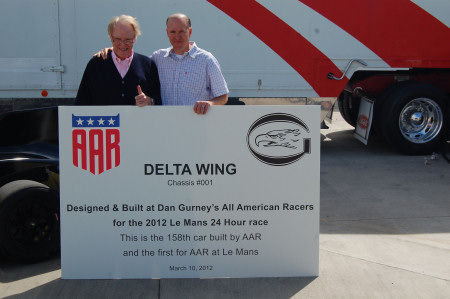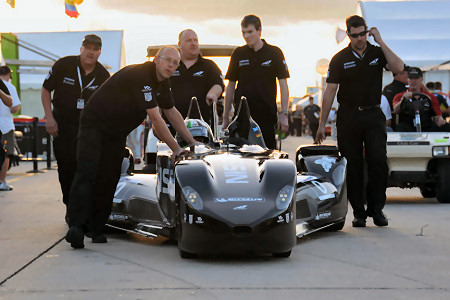The Way It Is/ The Delta Wing starts testingby Gordon Kirby |
 Ben Bowlby was in an ebullient mood when I talked to him a few weeks ago after the Delta Wing prototype ran its first laps at Buttonwillow Raceway. The car was driven that momentous day by Alex Gurney, Erik Comas and Marino Franchitti and all three were delighted with the novel experience.
Ben Bowlby was in an ebullient mood when I talked to him a few weeks ago after the Delta Wing prototype ran its first laps at Buttonwillow Raceway. The car was driven that momentous day by Alex Gurney, Erik Comas and Marino Franchitti and all three were delighted with the novel experience.
"The feedback was it's got better straightline stability than anything they'd ever driven," Bowlby enthused. "They said it was like a completely stable arrow. You could lock the rear brakes without having any control issues. The brakes are very powerful and the changes of direction were described variously as brilliant and amazing. In fact, the cornering capability at low speed on very hard tires was beyond our expectations. So that was really good. There was absolutely no understeer, none at all. So it was a pretty good first run. "It was actually better than I thought," he added. "The tire temperature balance, the brake bias and temperature balance, the traction, the braking and straightline stability, the high-speed grip--all those things, it did what we thought it was going to do. From a dynamic standpoint we haven't come across one element that isn't what we expected. In fact, it's even better."  © Paul Webb "Alex just did gentle laps," Bowlby reported. "We said let's go out and make the sure the wheels don't fall off and things like that, which is just being prudent. Alex did two or three outings and began to push it a little and came in and said. 'This thing feels incredible. It's glued to the track at high speed and it's got incredible change of direction.'." After Gurney's preliminary laps Comas got in the car. A veteran long-distance racer who's contracted to Nissan the Frenchman was there to provide an official view for the Japanese manufacturer. "He immediately went hard on the gas," Bolwby said. "He didn't mess about and after he few laps he came in and said. 'It's incredible, absolutely incredible!' He said the grip was tremendous and the change of direction was something he'd never felt before. He said the other thing that was extraordinary was it was the most stable car he had ever experienced." The car ran for three days at Buttonwillow before bad weather brought the test to an end. "A sandstorm came in and ended our test," Bowlby said, "which was a bit of a shame because we were just getting going. But we put some serious laps on the car." The only problem was with the transmission's electronics. "We had some gearbox issues that were a problem with the electronics, not the mechanicals," Bowlby noted. "We got some shrapnel as a result of the electronics but we've got that problem fixed. But the important thing is, she works!" The Delta Wing made its first public appearance last week with a few demonstration runs at Sebring prior to the 12 hour race. This week the car is undergoing four days of testing at Sebring driven by Marino Franchitti and Michael Krumm who will race the Delta Wing at Le Mans in June.  © Paul Webb "This car was designed for what the auto industry stated they wanted," Bolwby said. "They said wanted to have high-level racing with road-relevant, down-sized, modern cars with four-cylinder direct injection turbocharged engines--the 'Global Racng Engine'. Two years go at Sebring I met with all the players that were present and told them about the plan. All of them gave me time and were interested but only Nissan stepped up." As everyone knows the Delta Wing prototype was built at All American Racers in California. For more than a third of a century AAR was a hotbed of motor racing innovation with its superb run of Eagles. Because of his superb record as a driver, team owner and car builder, I consider AAR boss Dan Gurney to be America's most accomplished racing man. So I was fully convinced the concept would work after Dan sat down with Bowlby to analyse the car's theories and potential before deciding to jump in and build the Delta Wing prototype. "We volunteered to do our best to make it happen," Gurney said last week. "I've had faith in it since the beginning when I had a very thorough conversation with Ben and as we've watched it evolve we only gained more faith. It's been a big thrill to be involved in." Dan emphasized the Delta Wing's likely historical importance.  © John Zimmermann Gurney stressed that the Delta Wing's striking shape is its most powerful and effective calling card. "It is radical and unique and innovative enough that salesmanship alone wasn't going to enable it to be established," he remarked. "The Delta Wing itself is the best salesman of the concept and we're delighted that it has some Eagle DNA in it. We're also very proud of the international team that we have had the pleasure of working with on the project. "But in the end, it's just a thrill for all of us to be involved with something where the car is its own best salesman. All of a sudden the chin music stops and there it is." The Delta Wing was developed first in CFD, then in full-scale in the Windshear wind tunnel. Further development took place with a one-third scale model in AAR's half-scale tunnel in Santa Ana. Bowlby stressed the value in applying to the Delta Wing the BLAT (Boundary Layer Adhesion Technology) principles first pioneered by AAR thirty years with the 1981 Eagle-Chevy Indy car designed by Trevor Harris, John Ward and Gurney. "We applied the BLAT ideas after talking with Dan and John Ward," Bowlby said. "We pulled out the old drawings and put the '81 Pepsi Challenger up on stands and measured it and adapted the area, ratio and vortex-spilling side profile to the Delta Wing. The first run with the BLAT stuff on the car it pulled the best numbers we'd seen with the car running at high ride height. At low ride height it wasn't as efficient but it had a lovely characteristic inasmuch as the downforce increases as the car rises higher off the road so that when the car is car going through the corners at lower speed it is making the maximum downforce. "So following the BLAT path was a great way to go and a great homily to the genius of Dan Gurney, Trevor Harris, John Ward and their team of people who did this thirty years ago only to have it banned for being too good of an idea. It's very fitting that the BLAT concept has a new lease of life on the Delta Wing. Dan and his people take great satisfaction from it and rightfully so."  © John Zimmermann "Initially, when we said let's go for it," Gurney said, "we assumed--which you never should do--that the design was 90 percent complete. That wasn't the case, but that's the way it is with a brand new car. "One of the neat things about the whole concept is that it is chock full of different physics that have been thoroughly proven but never pulled together and set up this sort of a totem pole. That kind of science follows through from all the things that are most important down to the foundation and those that are the least important parts." Dan stressed that it's difficult to assess the Delta Wing's potential because there's no baseline to draw from like there is with most new cars. "When you look at something that is essentially an unknown and then you start gathering data on it in a wind tunnel or computer simulations you continually wonder if you are achieving 98 percent of what's there or are you achieving only 89 percent of what's there? You just don't know." Of course Bowlby enjoys a distinguished pedigree as a widely-accomplished race car designer of Lola Indy and Le Mans sports cars as well as enjoying a successful nine-year tenure as Chip Ganassi's technical director overseeing Chip's Indy, NASCAR and Grand-Am cars. Given Ben's sober record of success I've always raised an eyebrow at those who've questioned or ridiculed the Delta Wing and Gurney chuckles at the car's many detractors.  © John Zimmermann Dan believes that by redrawing the performance chart of power and fuel required to achieve competitive lap times the Delta Wing can help push the sport down a new, socially-responsible path. "I think it's a great thing for racing," Gurney observed. "If it does change the graph a little bit it can make a good contribution to what many people and all the politicians talk about, which is improving efficiency. If it can do that it will be a tremendous thing for the Delta Wing concept and for racing as a whole." Bowlby doesn't underestimate the giant task that lays ahead for his design team and Duncan Dayton's Highcroft team. There's not a tougher challenge in racing to debut a brand new car and concept at Le Mans and if the Delta Wing runs competitively and well in France next June it will capture the world's attention beyond the confines of motor sport. "There is a huge task ahead," Bowlby said. "Just because the car works everybody thinks we've done it. But we've only just started our work. Clearly, a lot of people didn't think it was going to work, but now that we've shown it does it's created huge interest and enthusiasm. When you look at the hundreds of thousands of hits on the videos and websites people are genuinely interested in the story and it looks like Nissan were wise to be bold and courageous and prepared to challenge the status quo." More than ever the Delta Wing is shaping up as a massively lost opportunity for IndyCar. Lacking any boldness of imagination or belief in innovation IndyCar's timid rulemakers settled instead on a revised but thoroughly conventional Dallara. They could not imagine a revolutionary new Indy car designed and built at AAR in California with the production cars built by a consortium of American companies. Panoz or Swift could have been enlisted to build the chassis, C&R Racing to build the suspension hardware and many other pieces, and a guy like Bruce Ashmore brought in to tie it all together and work as chief development engineer.  © Paul Webb As we all know so much of motor racing has been stuck in a rut in recent years, if not decades. In open-wheel racing we've seen no new concepts since the appearance more than thirty years ago of the classic ground-effect cars like the Lotus 79 F1 car and Chaparral 2K Indy car and over the past ten years the spec car plague has infected most forms of the sport. Even Formula One suffers from a very restrictive rulebook which defines the overall layout of the car and many other details so that the untrained eye can discern little or no difference between an F1 car of today and one from fifteen years ago. Imagine yourself fifty or sixty years ago as a fan of the beautiful Indy roadsters of the late 50s and early 60s or the classic Maserati 250F, Mercedes-Benz W196 or Dino Ferrari Formula One cars from the mid-fifties. If I suggested to you that those superb cars were about to be replaced by an invasion of tiddly little rear-engine Coopers and Lotuses you would have said I was crazy. But it happened, almost overnight, between 1958-'61 in F1 and 1963-'66 in Indy cars. The rear-engine revolution was followed in quick order by the arrival of low profile tires, wings, ground-effect and turbocharging. By the seventies F1 and Indy cars had changed out of all recognition from what they had been in the fifties but since the arrival of ground-effect the cars have largely become frozen in time. More's the reason to hope that the Delta Wing is successful. I've written eight previous columns and a bunch of blogs for Motor Sport about the Delta Wing, starting in February of 2010 when Chip Ganassi first leaked some early details about the concept. For those who are interested here's a list of the eight other columns I've written about the Delta Wing. They're readily accessible in my 'previous columns' archive. 2/22/10 #222: Explaining the Delta Wing concept 3/1/10 #223: How the Delta Wing will come to life 5/24/10 #235: The Delta Wing's virtuous circle 6/9/10 #238: Why the Delta Wing will work 1/7/11 #268: Will the Delta Wing fly? 6/9/11 #289: Eagle Delta Wing for Le Mans 6/27/11 #292: All American Racers and the Delta Wing 7/11/11 #94: The ALMS and the Delta Wing |
Auto Racing ~ Gordon Kirby Copyright 2012 ~ All Rights Reserved |
